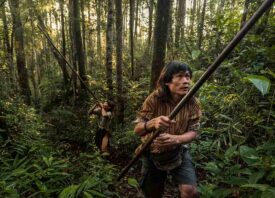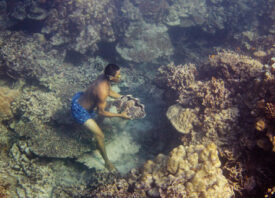Search this site
Photographer Captures the Sea Gypsies of Borneo and Their Vanishing Way of Life
A sea gypsy family.
Large extended families live in stilt houses off Denawan Island in Sabah.
When Australian photographer Mark Lehn met Misma, a woman living along the waters of Sabah, Borneo, he discovered that she could not precisely remember her age: the nomadic lifestyle of the Bajau Laut of Malaysia, descended from the islands of the Philippines, is so demanding that many do not live into old age. Misma and her people pledge allegiance not to any state but to the sea itself; their families make their homes in small boats called Lepa Lepa or in wooden houses raised on stilts.
Lehn has long held a fascination with sea nomads of the world, but what drew him to the Bajau Laut, in particular, was the urgency of their situation. Close by, the militant group Abu Sayyaf makes its base in the Southwestern Philippines, and the Malaysian military is stationed throughout the area, limiting the trade possibilities of the Bajau Laut with strict curfews and regulations. Without a home on land, the community faces the temptation of conforming and adapting to mainstream society, leaving behind a way of life that their ancestors have practiced for centuries.
Like the people who survive off its riches, the sea itself is under constant threat, as its wildlife is increasingly exhausted. Moving through the community by boat with a Bajau interpreter, Lehn listened to the people and their stories; despite the threats posed by globalization and outside forces, they welcomed him into their midst after the local community leaders had given the stamp of approval. At one point, he was warmly invited to attend a private wedding at Denawan Island. He saw the hands of the elderly—sometimes with fingers missing, lost to the old and now-illegal practice of blast fishing.
Because they are citizens only of the sea, unrecognized by a government or a homeland, the future of the Bajau Laut is a precarious one. The children do not have access to schools or other public services, making it almost impossible for them to continue life as their predecessors have. Someday, this way of life might be gone forever.

Lion, a Bajau Laut, is out fishing off Denawan Island.

Sea gypsies are exposed to the elements and live a harsh life. Many do not live to be elderly like Misma, who does not know how old she is.

Buggarah, an elderly Bajau Laut woman, stands on her boat off Denawan Island.

A Bajau Laut family boat or Lepa Lepa off Denawan Island.

A Bajau Laut woman is with her husband fishing off Denawan Island.

A Bajau Laut fisherman out fishing off Si Amil Island.

Most Bajau Laut today have moved to the islands but they are still strongly connected to the sea. They live in villages of frail stilt houses made from wood and nearby resources over the Celebes Sea. They lack many creature comforts like electricity, gas and running water. Wooden planks between the houses connect their community.

A successful day fishing for a Bajau Laut couple.

Bajau Laut women like Indda wear pounded rice powder as face paint to protect their skin from sun damage caused by the water’s reflection.

A community of Bajau Laut live off the coast of Bodhgaya Island in stilt houses.

Although these young Bajau Laut teenagers on Kulapuan Island look menacing with their makeshift balaclavas, they are worn as sun protection for fishing in the shallows.

Riki cooking fish ‘kupput’ on her family’s Lepa Lepa.

After a successful day fishing the catch are salted.


Mohd Yazid is moving a squid decoy around the water to entice octopus out of the shallow reef.

Sanglia is cooking tapioca in her family’s Lepa Lepa.
All images © Mark Lehn





